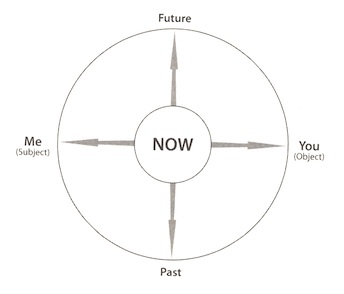 The Mandala of Being: A Compass for Living
The Mandala of Being: A Compass for Livingin the Now
By Richard Moss
Author of Inside-Out Healing: Transforming Your Life Through the Power of Presence
Mandala is a Sanskrit word meaning "circle." It has been a universal symbol over millennia, particularly in Eastern Spiritual traditions. In those traditions, mandalas are a form of sacred art -- elaborate paintings that symbolically depict the journey from the world of illusion created by the ego to the realization of the timeless self at the center of us all.
The Mandala of Being is a simple way of modeling how your thinking mind operates relative to being aware in the present moment. It teaches you how to consistently live in the Now by graphically illustrating that there are only four places your thinking can carry you into when you aren't fully grounded in the present. Once you grasp the four ways you leave the Now, you simultaneously understand how to return to your aware self, which always in the Now.
A practical tool for the practice of presence, the Mandala of Being will help you wake up and live more in awareness instead of in your head. In this way, you learn how to meet life's greatest challenges with much less suffering. And sometimes, a deep experience of presence results in physical healing.
Spend a few moments contemplating the following diagram. It is a representation of every single moment of your life. Notice that the arrows are pointing away from the Now and toward Me, You, Past, and Future. This represents where your thinking mind takes you when you are not truly present. As we progress in the work with the Mandala, you will see that what you are learning is how to turn those arrows around so that you are grounded in the present, in awareness.
The Mandala of Being : The Four Places the Mind Goes When Attention Leaves the Now

If you answered "One," look again. The Mandala of Being illustrates that there is only Now, but in a psychological sense, there are five different states of Now.
First and foremost, there is a particular quality of "Nowness" represented by the central Now position that is your aware self. In this central Now, you are fully embodied in the present moment. It can be likened to the state of flow or meditation. Your body is awake and ready, yet profoundly relaxed; your mind is simultaneously focused yet spacious. You are present with, and not at all in conflict with, what is. This state is what is meant by the expression Being in the Now. Relative to this, there are four other states of Now-ness:
1. The Past position represents when your thinking mind carries you into the past, and you identify with your thoughts about specific memories. Past stories will either generate a sense of pleasant reminiscence (for example, remembering something that made you proud or happy) or unpleasant reminiscence (as when you remember a situation that made you feel sad, guilty, or regretful).
2. The Future position represents any moment when you identify with your thoughts about the future, and as a result, your emotional state becomes determined by the nature of those thoughts. Since the future is always imaginary, these Future stories will either generate positive anticipation with emotions of hopefulness or eagerness, or negative anticipation with emotions of anxiety or even terror.
3. The Me position represents the emotional quality you experience in the present moment as a result of identifying with your judgments about yourself. As we have discussed, Me stories inevitably make you feel special: either grandiose or depressive.
4. And, finally, the You position represents what happens when you identify with your beliefs and judgments about other people or anything else you can think of: your career, the situation you are in, money, politics, God. . . the list is really endless. These stories will either elevate or diminish the person or thing you are thinking about, and as you identify with these You stories, you will experience emotions ranging from adoration to hate to hurt.
What the Mandala shows is that your emotional reality is not caused by something outside you. Rather, it is caused by your own thoughts: the stories you tell yourself about yourself, others, the past, and the future. These are the four ways you build a mental reality that is not actually real and in which you can create immense emotional suffering. You lose connection to your true self.
By working with the Mandala model, you will start to understand the relationship between what you are thinking and the emotions you are feeling, along with the corresponding effects you experience in your body.
The above is an excerpt from the book Inside-Out Healing: Transforming Your Life Through the Power of Presence by Richard Moss. The above excerpt is a digitally scanned reproduction of text from print. Although this excerpt has been proofread, occasional errors may appear due to the scanning process. Please refer to the finished book for accuracy.
Copyright © 2011 Richard Moss, author of Inside-Out Healing: Transforming Your Life Through the Power of Presence
Richard Moss, MD, author of Inside-Out Healing, is an internationally respected leader in the field of conscious living and inner transformation. He is the author of six seminal books on using the power of awareness to realize our intrinsic wholeness and reclaim the wisdom of our true selves. He lives in Ojai, California.
For a calendar of future seminars and talks by the author, and for further information on CDs and other available material, please visit richardmoss.com and follow the author on Facebook and Twitter.
RETURN TO OMPLACE HOME